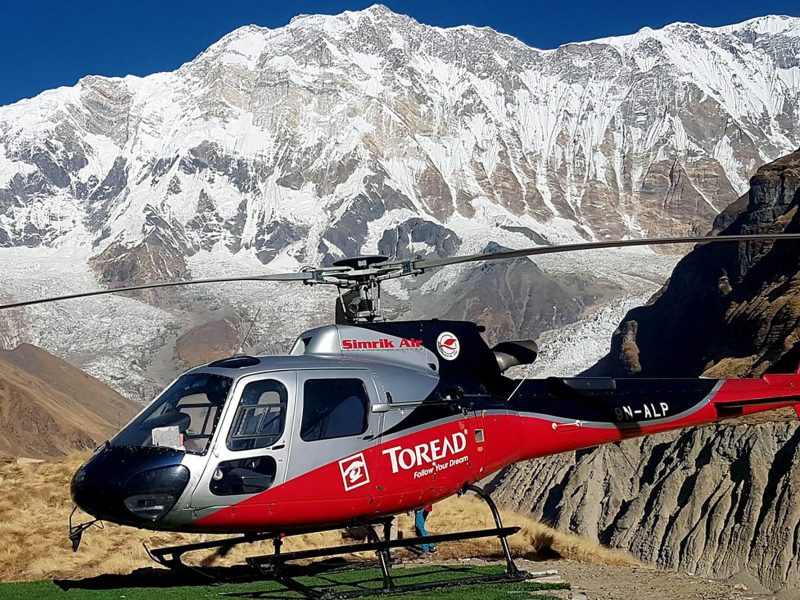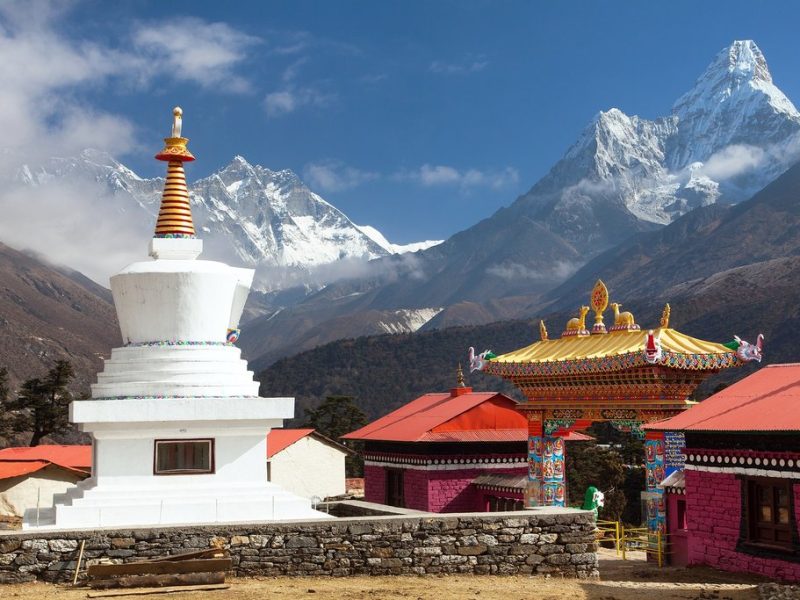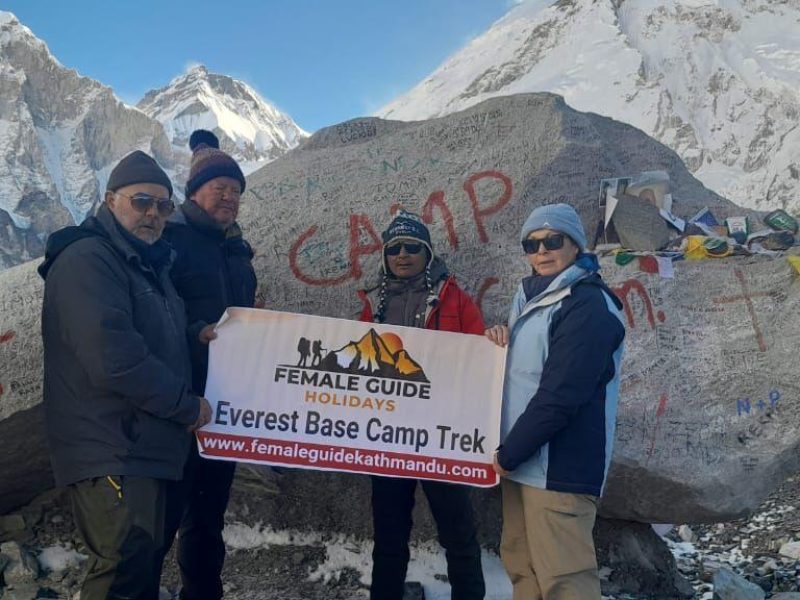If you’re looking for an adventure of a lifetime then here is your Ultimate Guide to Everest Base Camp, & trust me this is the place to be. Everest Base Camp is located in the beautiful Khumbu region of Nepal, and it’s the starting point for those who wish to climb Mount Everest.
Whether you’re an experienced trekker or someone who loves the outdoors, Everest Base Camp is the perfect destination. This trek is a once-in-a-lifetime experience. It will take you through stunning landscapes, breathtaking views of the Himalayas, and traditional Sherpa villages.
So, what are you waiting for? Keep reading to learn more about Everest Base Camp, and plan your adventure today with Female Guide Kathmandu!
Guide to Everest Base Camp: An Overview
Everest Base Camp is a popular trekking destination in Nepal’s Khumbu region. At an altitude of 5,364 meters, it’s the starting point for mountaineering expeditions to the summit of Mount Everest. The area is culturally significant to the Sherpa people, who live in the region and are known for their mountaineering skills.
Check Out Everest Base Camp Trek – Full Itinerary (Click Here)
Everest Base Camp has a rich history of mountaineering. The first successful climb of Mount Everest was made in 1953 by Sir Edmund Hillary and Tenzing Norgay. Since then, thousands of climbers have attempted to summit the mountain, with many starting their expeditions from Everest Base Camp.
The camp is also an important hub for trekkers who want to experience the beauty of the Himalayas. There are several trekking routes to Everest Base Camp, each with varying difficulty levels. The most popular routes include the classic Everest Base Camp trek, the Gokyo Lakes trek, and the Three Passes trek.
Trekking to Everest Base Camp
Trekking to Everest Base Camp is an adventure of a lifetime, offering breathtaking scenery and a chance to experience the unique culture of the Himalayas. There are different treks available, each with its highlights and challenges.
Classic Everest Base Camp Trek
The Classic Everest Base Camp trek is the most popular route to the Base Camp. It takes you through stunning villages, forests, and suspension bridges over the Dudh Kosi River. The trek starts in Lukla and passes through Namche Bazaar, a trekking hub. It takes about 12-14 days to complete the trek.
Gokyo Lakes Trek
The Gokyo Lakes trek takes you through the stunning turquoise lakes at Gokyo. The trail offers breathtaking views of the Himalayas and the Ngozumpa glacier. This trek is slightly more challenging than the classic route but rewards visitors with stunning scenery. It takes about 14-16 days to complete the trek.
Three Passes Trek
The Three Passes trek is a more challenging trekking trail to the Everest Base Camp. It takes you over three high mountain passes, including the Kongma La, Cho La, and Renjo La. This trek offers incredible views of Mount Everest and other peaks and a chance to experience the local culture and way of life. It takes about 18-20 days to complete the trek.
Overall, trekking to Everest Base Camp is an incredible adventure that offers visitors a chance to experience the natural beauty and culture of the Himalayas. With the right preparation and guidance, visitors can enjoy breathtaking views, challenging hikes, and a truly unforgettable journey.
Learn More About Our: Three Passes Trek (Click Here)
Preparing for a Trek to Everest Base Camp (Guide to Everest Base Camp)
You must be in good physical shape to trek to Everest Base Camp. You’ll walk for several hours daily, and the terrain can be steep and challenging. Therefore, preparing yourself by exercising regularly for at least six months before the trek is crucial. Start with light exercises such as walking and gradually increase the intensity. It will help you build your endurance, strength, and flexibility.
The right gear and equipment are crucial for a successful trek to Everest Base Camp. You’ll need warm and waterproof clothing, sturdy hiking boots, a backpack, a sleeping bag, and a trekking pole. Bring a first-aid kit, sunscreen, sunglasses, and a hat. You can rent or buy the necessary gear and equipment from the local stores in Kathmandu or Lukla.
Safety should always be a top priority when trekking to Everest Base Camp. The high altitude, cold weather, and rugged terrain can be dangerous if you’re unprepared. Therefore, acclimatize properly by taking rest days and drinking plenty of water. Always follow your guide’s instructions and stay on the trail. It’s also essential to have travel insurance that covers medical emergencies and evacuation.
Accommodations and Facilities
When trekking to Everest Base Camp, you’ll need a place to rest and recover after a long day of hiking.
You can find various accommodation options along the Everest Base Camp trek. It ranges from basic teahouses to more luxurious lodges. The teahouses are simple and affordable, providing a bed and a shared bathroom. You can also find private rooms with attached bathrooms and amenities like Wi-Fi, hot showers, and restaurants. The private rooms are mainly available lower in the trail.
You can get meal options from traditional Nepali cuisine to international dishes. Teahouses and lodges offer set menus, including breakfast, lunch, and dinner. You can expect dal bhat, momos, pasta, and pizza. Drink plenty of water and avoid uncooked or unhygienic food to prevent altitude sickness. Once you start climbing higher, the food options will be limited.
While trekking to Everest Base Camp, preparing for medical emergencies is crucial. Most teahouses and lodges have basic first aid kits, but carrying your own is always advisable. If you need medical attention, nearby villages have clinics and hospitals. Additionally, helicopters are available for emergency evacuations.
Best Time for Everest Base Camp Trek
The best time to trek to Everest Base Camp is during the pre-monsoon and post-monsoon seasons. The pre-monsoon season runs from March to May, while the post-monsoon season is from October to November.
Pre-Monsoon Season
The pre-monsoon season, or spring, is the best time to visit Everest Base Camp. The weather is dry and mild during this time, making it ideal for trekking. The skies are clear, and the views of the Himalayas are stunning. The temperature during the day is around 10-15°C, and it can get cold at night. It’s essential to pack warm clothes for the evenings.
Post-Monsoon Season
The post-monsoon season, also known as autumn, is another excellent time to visit Everest Base Camp. The weather during this time is dry, and the skies are clear. The temperature during the day is around 15-20°C, and it can get colder at night. The post-monsoon season is also when the famous Tihar festival is celebrated in Nepal.
Monsoon Season
Trek to Everest Base Camp during the monsoon season, which runs from June to September, is not advisable. The region receives heavy rainfall during this time, and the trails can be muddy and slippery. The views of the Himalayas are also obstructed by clouds, making it difficult to enjoy the scenery.
Things to Do and See at Everest Base Camp
Trekking to Everest Base Camp offers an unforgettable adventure with plenty of things to see and do.
Visiting Nearby Villages and Monasteries
During your trek, you’ll pass through several traditional Nepali villages, offering a glimpse into the local culture and way of life. You can explore ancient monasteries, visit local schools, and learn about the unique Sherpa culture. The villages of Namche Bazaar, Tengboche, and Dingboche are popular spots to visit.
Views of the Himalayas and Mount Everest
One of the main highlights of trekking to Everest Base Camp is the stunning views of the Himalayas and Mount Everest. You’ll see snow-capped peaks, glaciers, and stunning landscapes throughout your trek. The views from Kala Patthar, a nearby peak, are particularly breathtaking, offering panoramic views of Mount Everest and the surrounding mountains.
Other Adventure Activities in the Region
Besides trekking, there are plenty of other adventure activities in the Everest region. You can go mountain biking, rock climbing, or white-water rafting. You can also enjoy scenic helicopter tours or paragliding. These activities offer a unique way to explore the region and make your trek more memorable.
Highlights of the Trek
The trek to Everest Base Camp is challenging, but the rewards are well worth it. Here are some of the top highlights of the trek:
- Trekking through the beautiful Sagarmatha National Park
- Passing through traditional Nepali villages and monasteries
- Enjoying breathtaking views of the Himalayas and Mount Everest
- Reaching the Everest Base Camp and seeing the famous Khumbu Icefall
- Climbing to Kala Patthar for panoramic views of Mount Everest
Conclusion
In conclusion, Everest Base Camp is the perfect destination for combining breathtaking scenery, unique culture, and physical challenges. The Base Camp offers an opportunity to connect with the local community and learn about their way of life.
To ensure a safe and enjoyable trek, prepare well in advance, and include physical training. You also need to get the appropriate gear and equipment. It’s also essential to take safety measures and precautions on the trail.
Female Guide Kathmandu offers tailored tours to Everest Base Camp that cater to different preferences and fitness levels. Our experienced guides will provide the necessary information and support to make your journey comfortable and memorable.
Don’t miss out on this once-in-a-lifetime opportunity. Contact us today to book your trip to Everest Base Camp and discover the beauty of the Himalayas.



